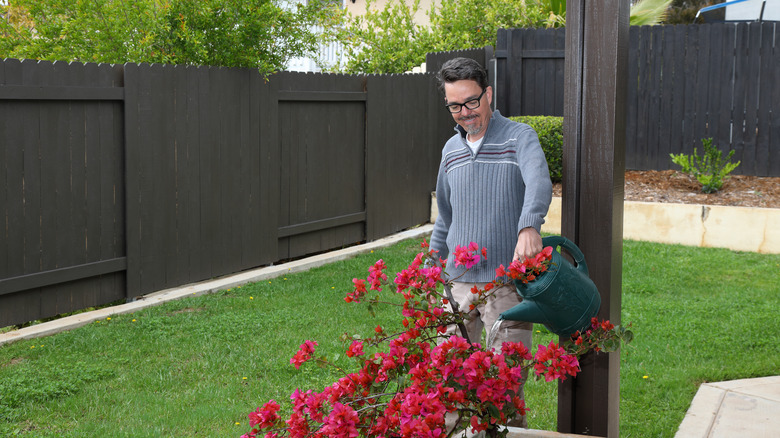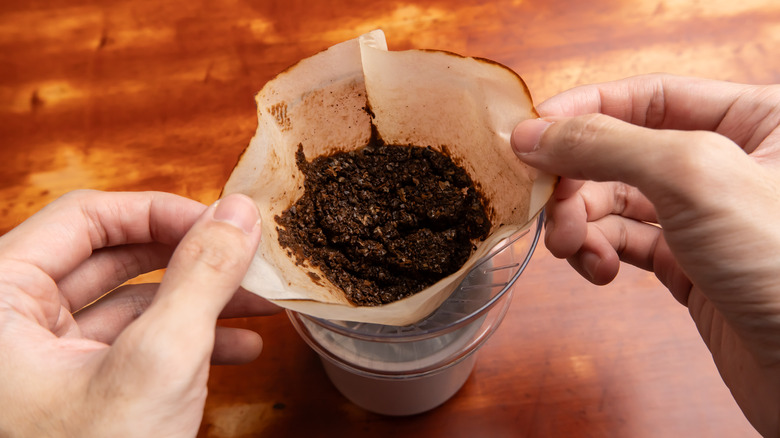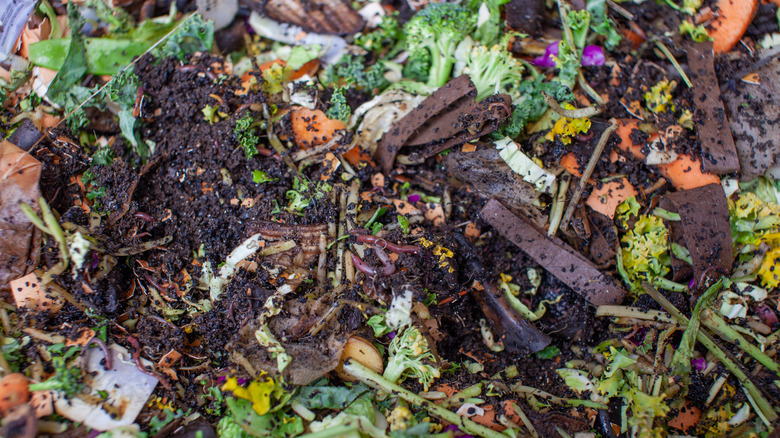Help Your Bougainvillea Bloom With A Kitchen Scrap You're Likely Throwing Out
Despite being notorious for its thorn-coated branches, bougainvillea is beloved by gardeners worldwide for its easy-going nature (it's well-known to be super hardy) and vibrant flower clusters in an astonishing selection of red-spectrum colors. That it thrives in both garden beds and containers only adds to its popularity for urban and rural gardeners alike. Native to various locales across South America, the vine growing in your backyard is likely Bougainvillea spectabilis, Bougainvillea glabra, or Bougainvillea peruviana — or one of these three species' near-endless hybrids and cultivars. No matter the origins, the plant needs well-draining, slightly acidic soil with pH values of between 5.5 and 6.0. Higher values — in other words, soil that's more alkaline than acidic — could be the reason your bougainvillea may not be blooming.
Brewed coffee bean grounds are purported to have lots of uses in the garden, many of which your lackluster bougainvillea vine may benefit from. Your local café offers patrons and passersby to take home their used grounds for free for a good reason — demand for the brown stuff is high. Notice we said "may" benefit from? That's because the efficacy of coffee grounds for plant health is debated by garden experts, especially regarding acidification. Some say that, at best, they provide nitrogen, work okay as a mulch, and reduce soil alkalinity a bit. Others refute these claims entirely, even going so far as to suggest coffee grounds could harm your plants.
A good or bad grind?
The trouble is that coffee grounds might not be a soil alkalinity or nutrient cure-all for fading bougainvilleas. According to Oregon State University, brewed coffee grounds boast a pH of 6.5 to 6.8, which is neutral on the scale. What's more, they aren't a significant source of nitrogen, the macronutrient responsible for plant growth, or vital micronutrients — though they do have some, most notably potassium, phosphorus, calcium, and magnesium. Essentially, the idea is that while the grounds won't harm your soil, the benefits to soil acidity are minimal at best.
The research into whether coffee grounds help or hinder plant growth is highly contradictory. An HGTV article notes that while soybeans and cabbage crops benefited from coffee inputs in some studies, clover and alfalfa seeds failed to sprout in others. Other recent research found that even composted coffee grounds reduce plant growth due to the high concentrations of caffeine they retain, even after brewing. Plus, they're antibacterial. This is good if you want to eliminate soil pests but not so good if you're trying to cultivate a healthy soil microbiome. However, this doesn't mean that coffee grounds aren't the kitchen scrap that'll do wonders for your growing bougainvillea. Some gardening experts still recommend using the grounds as light mulch, slow-release fertilizer, and a compost or worm bin addition. The material is also potentially useful as one small part (rather than the entirety) of a homemade fertilizer mix, adding much-needed nitrogen.
How to use coffee grounds with your vine
It's best practice to compost your coffee grounds before using them in the garden. To reduce the acidity, which is sometimes necessary even for acid-loving bougainvillea, add lime to the coffee at a 10:1 ratio or leaves at a 4:1 ratio before composting. Ensure coffee grounds take up less than 20 percent of the pile. Make a homemade fertilizer mix by adding one part coffee grounds to compost, bone meal, wood ash or kelp, eggshells, and Epsom salt. Alternatively, dig grounds into the first 4 to 8 inches of soil as an amendment or acidifier. You can also layer them atop the garden bed as mulch. An additional layer of organic matter (like leaves, bark, or wood chips) stops the grounds from becoming hydrophobic as they dry while trapping the nitrogen they release as they decompose.
A word of caution: Think twice before using coffee grounds to fertilize your bougainvillea. Some plants, like tomatoes, grow poorly in the presence of coffee grounds. Monitor plants near your vine for signs of distress. A coffee grounds mulch layer could attract not-so-fun fungi (like mold) to your garden beds or planters. And, while coffee grounds aren't as acidic as once thought, it's still worth keeping an eye on the acid content in the soil you've added them to. Regular testing can help you determine pH levels and when to start or stop adding coffee grounds or compost amended with the substance.


